Herbs are one of the favourite things to grow at home but for many people they simply don’t have access to a garden. Thankfully, herbs can easily be grown indoors, as long as you make sure to get started off the right way. To create a successful indoor kitchen herb garden you need to understand each plant’s requirements and make sure to give them what they need. It’s really that simple! Today we are going to go over our top 10 tips for indoor herb gardens, as well as how to care for our top 10 herbs!
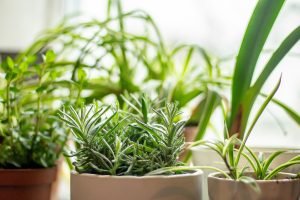
1: Provide Plenty of Light for Indoor Herb Gardens
Did you know the intensity of the light you provide your plants contribute to the flavour of your herbs? So the more light you can provide, the better off your plants will be. Good light will also encourage plant growth and is one of the most important factors in successfully growing herbs indoors.
Herbs need at least 6-8 hours of direct sunlight each day. A bright, sunny window or sunroom is the best location for growing your herb gardens indoors. You can always add a small table directly in front of the window if the windowsill is not large enough to comfortably fit your herb pots.
If you have no place for a table, you can also get window shelves with suction cups that help create a good growing environment for your herbs.
If you don’t have a window that is bright enough window, you can still successfully grow herbs indoors. You just need to provide an additional light source. A simple task light with a CFL bulb is all you need If you’re only growing 1-2 herb pots. Small grow light set ups are also available from many garden centres and online. This gives you more options on where to place your herb garden, from a kitchen counter to a wall unit. Chives, mint, and parsley are all herbs that do well in less direct sunlight.
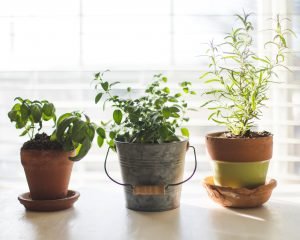
2: Provide the Right Temperature
Temperature is nearly as important as light when it comes to growing herbs successfully indoors. The ideal temperature for most herbs is between 18 – 21°C, which works well for most homes. If you want or need to slow the growth of your herbs, you can reduce your indoor temperature to 15°C. this can cause your plants to enter a dormant period.
You should be careful when placing herbs directly next to a window. If the leaves touch the glass, they could burn as the glass heats up with the reflected sunlight. If your home has drafty windows, however, it might be too cold to have your indoor herb gardens next to a window. You can remedy this by adding insulation to your windows or placing a towel between the window and the screen.
Basil is especially particular when it comes to temperature. Basil prefers the warmth and would prefer to be at a constant 23°C where possible. When basil gets too cold the leaves will start to wilt and discolour, usually within 24 hours.
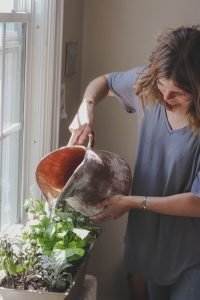
3: Water Properly
When it comes to watering herbs it is important to allow the pots to dry out between watering. Make sure you test the soil in each pot by sticking your finger in about 2 inches into the soil. If it is dry, then it’s time to water your herbs. Don’t worry that the soil is too dry and harming your plants. Soil dries out from the top down, so the soil is still moist toward the bottom of the pot. The aim is to encourage the plants to develop a healthy root system that grows deep down looking for water.
If the top layer of soil is dry when you test, it is time to water. Water your herb garden slowly to prevent water running straight through the pot and out the drainage holes before the soil has a chance to absorb it. Your plants don’t need to be watered daily and it’s best not to keep to a schedule. Instead, test your soil regularly and water only when dry. This will vary according to the season and the temperature in your home.
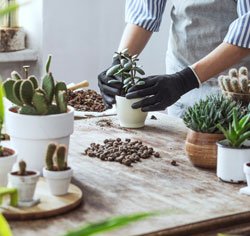
4: Select the Right Pots for Your Indoor Herb Gardens
After light, temperature, and water, choosing the right containers for your indoor herb gardens is an important factor in determining the success of your garden. You can make your own pots, but make sure to include drainage holes and saucers.
Drainage
Drainage is incredibly important for your herbs. They don’t like to be kept in standing water, so there needs to be a way for the water to drain out of the pot. As a result, any pot you use, must have adequate drainage holes. If you’re not sure if your pot or container will drain well, fill it with water and watch how quickly or slowly the water drains. If it drains too slowly, add some pebbles to the bottom of the container so the roots of your plants aren’t sitting in the water. Do this before you fill your container with soil.
Saucers
When growing any plant inside, it’s important to have a saucer. Saucers capture any excess water to prevent any damage to your table, flooring, or rugs. This, in turn, prevents things like dry rot and mould. Some pots will come with saucers or will have saucers attached to them. You can also buy saucers for a few dollars from garden centres like Aumanns. Decorative trays and old plates can work as well.
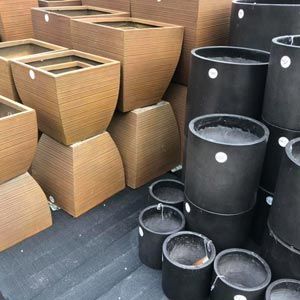
Size
Choosing the right sized pot is a must, as well. The right size will differ depending on the types of herbs you are growing. Basil, for example, has longer roots and will need a deeper pot. Mint, however, doesn’t need a pot as big. Choosing a pot that’s too big for your plant makes it hard to keep the soil evenly moist. But if the pot is too small, the plant’s growth will be stunted. Always research the needs of your herbs before adding it to your indoor herb garden.
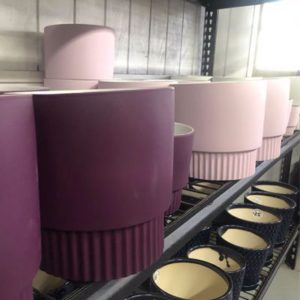
Materials
The right material for your indoor herb garden pots will depend on the humidity level of your home. The amount of moisture can be controlled by the type of pot you choose. Clay pots tend to dry out fast while ceramic pots will hold in water better. So if you have a drier environment, use ceramic pots instead of clay or more porous types of pots.
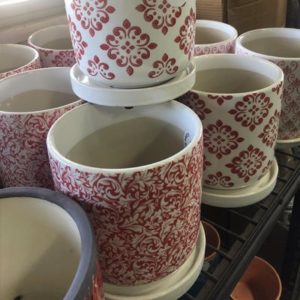
Design
This is where you can have fun when creating your indoor herb garden! You can spice up your kitchen, sunroom, or loungeroom with colourful pots. Or embrace your cottagecore dreams with stunning terracotta pots in all different colours. You can also keep to a modern feel and choose monochrome pot colours set in stunning metal stands. The sky is the limit when it comes to designing your indoor herb garden. You can even repurpose household items and turn them into unique herb planters. This makes for a great project for a family, to find things to repurpose an turn into unique containers to turn into herb pots.
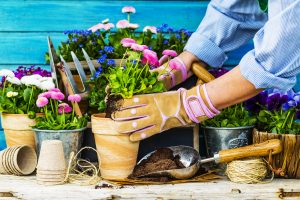
5: Grow Your Herbs in Separate Pots
While it is possible to plant multiple herbs in the same garden bed, you can’t plant multiple herbs in the same pot. This is because it is extremely difficult to create the perfect environment for multiple herbs in a single container. By planting in separate pots, you have much more flexibility when it comes to growing herbs indoors.
You might also need to rotate different herbs to improve the air circulation or adjust the amount of light they receive. This is something you can’t do if you plant multiple herbs in the same pot. Further, a plant is being attacked by a pest, like fruit flies, you can separate a single pot from the others, to prevent the pests passing on to the healthy herbs. By planting separately you can address each plant’s needs individually.
While you might buy your herbs from grocery or garden centres in cute little multi-herb planters, these are only temporary pots. If you want your plants to thrive indoors, you need to plant them separately.
6: Flush Indoor Herb Garden Pots to Remove Salt Build Up
Salt build up in pots can occur due to a number of reasons. The main one is due to fertiliser build up. We need fertiliser to keep herbs healthy, but over time salt residue can be left behind. Tap water can also leave behind an amount of salt. You will know if your plants are suffering from salt build up if you see a white substance around the rim of the container or pot. This build up will also be in the soil which, if left untreated, can cause your herbs to suffer.
To fix salt build up, you need to hold the pot over a sink and thoroughly water it until water runs from the bottom of the pot. allow the water to fully drain from the pot before placing it back in your indoor herb garden. repeat this every few months to ensure your plants remain healthy. this is why you need to ensure your pots have good drainage to prevent salt build up.

7: Choose the Right Soil for Your Herbs
Like all plants, the right soil is important to the health and growth of your indoor herb garden. For an indoor herb garden, you need a good soil that provides excellent drainage. If the soil feels too heavy, you can add some perlite to the mix. If you live in a very hot, dry climate, you can add vermiculite to the soil as it will actually hold the water in a little more so the hot, dry weather won’t dry the soil out so much.
We recommend buying a potting mix from a garden centre from Aumanns rather than digging up dirt from your garden or a local park, etc. This dirt is much too compact to be suitable for indoor growing. This will smother the roots of your herbs and they won’t be able to breathe. You will also transfer small bugs and parasites from this outdoor soil into your indoor herb garden that you do not want in your home.
If you want to make your own potting mix you can use a blend of coco peat or peat moss, perlite or vermiculite, and coarse sand. This is cheaper than a commercial potting mix and it lets you modify the soil to better suit the types of herbs you are growing. For example, mint loves moisture, which means it prefers soil with extra peat moss.
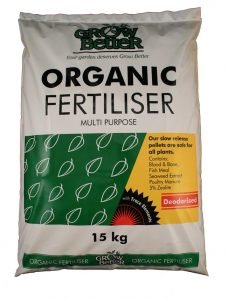
8: Fertilise Your Indoor Herb Garden
Herb gardens love a seaweed extract or fish emulsion fertiliser. Both of these fertilisers have a high concentration of nitrogen. This promotes strong, leafy growth. During active growth in the summer months you should fertilise once a week. During the slower growth periods, like winter, you can reduce this to once a month.
Many herb gardeners like to make a weak solution of fertiliser by mixing it into water so they fertilise their herbs every time they water. I you want to try this too, add the fertiliser at one-quarter of the strength indicated on the packet to the water.
9: Provide Good Air Circulation
Plants need good air circulation to remain happy and healthy. If herbs are planted or placed too close together they won’t receive enough airflow. This can contribute to spreading disease between plants. We recommend that you rearrange your plants occasionally so you refresh the airflow around the plant. This helps prevent the air becoming stagnant around your plants and gives them a little breathing room.
10: Show Your Herbs a Little Love
Yes, you heard us, your herbs need a little love just like your pets. Talking to your herbs actually does help because you’re releasing carbon dioxide that the plants use to convert to food. You should also gently brush your hand over the top of your herbs (and encourage your family members to do the same). The movement of “petting” your plant simulates the motion of wind blowing and will help encourage the stems to be stronger.
10 Best Herbs for Indoor Herb Gardens
Now that we know how to create the perfect environment for your indoor herb garden, it is time to find the perfect herbs. Below we’ve listed our favourite herbs that thrive in an indoor environment and make the perfect addition to any meal!
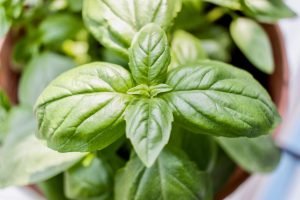
1: Basil
Start your basil from seeds and place the pots in a south-facing window. Basil loves a lot of sun and warmth. It needs plenty of water, so keep the soil moist but not drenched. Pinch out the tops of the plant frequently to encourage fuller growth.
You can add fresh basil to almost any dish, but it is perfect for pizza, pasta sauces, salads, ratatouille, and more. You can even puree extra leaves with a little water and then pour the puree into an ice cube tray. Freeze this tray and then you have basil to use later as part of pesto, soups, and sauces.

2: Bay
Bay is laurel and a perennial. It actually does best using the container gardening method. It loves an east or west facing window where it can get full to partial sun. Make sure you thin out the bay plant when it starts to get crowded. Bay also needs air circulation to remain healthy so ensure you rotate it regularly and don’t let it get crowded by other pots.
Bay leaves are excellent as a flavour in soups, sauces, and stews. It also makes a wonderful, fragrant and fresh smelling wreath if you end up with extra sprigs.
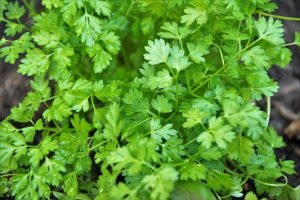
3: Chervil
A delicate annual and a favourite in French cuisine (hence its nickname French Parsely), chervil is best started from seed in spring or late summer. It prefers part light but it needs temperatures between 18 – 21°C to thrive. Like basil, you will want to pinch the tops out occasionally so chervil will continue to grow bigger and fuller.
Chervil leaves make an amazing addition to soups, fish dishes, vegetables, and poultry meals. You can also use it to make your own herb butter.
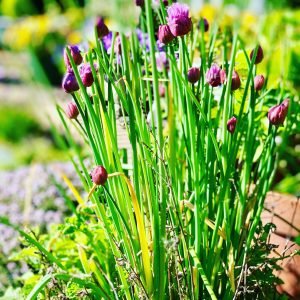
4: Chives
These onion-y herbs do well in a container in full sun. if you have chives in your garden already you can easily move it inside at the end of the growing season. Just dig up a clump from your herb bed and replant it in a pot. Leave the pot of chives outside until the leaves die back. In winter, move the pot to the coolest indoor spot for a few days. Then place it in your brightest window.
You can mince the leaves and sprinkle them into soups and salads or on top of eggs and baked potatoes. The purple flowers are also edible and make great garnishes.
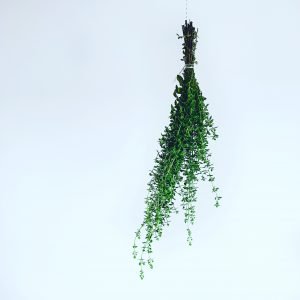
5: Oregano
A Mediterranean ground cover plant, oregano likes to grow low and spread. You can start growing oregano from a tip that has been cut from another oregano plant. Once you’ve planted that tip in a pot, place it in a south-facing window.
However, oregano doesn’t need as much as other herbs, so make sure the soil dries out between watering. It also like to be regularly trimmed to keep it healthy and looking full.
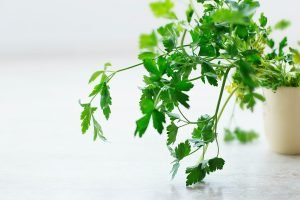
6: Parsley
The wilted bunches of parsley at grocery stores are often completely unappetising. Which is why growing parsley from home is so rewarding. Start parsley from either seed or dig up a clump from your garden at the end of the season. Parsley loves full sun but will grow very slowly if placed in an east or west facing window.
We recommend choosing a flat-leaf variety for cooking or the curly leaf variety for pretty garnishes on potatoes, rice, fish, lamb, steak, etc.
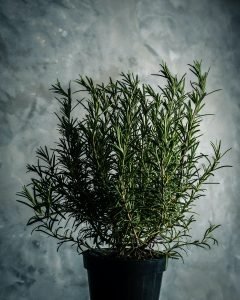
7: Rosemary
This is one of the classic herbs and an absolute favourite in cooking. Start rosemary with a cutting and keep it in a moist, soilless mix until it roots. Rosemary grows best in south-facing window with good drainage. Prune your rosemary plant regularly (prune up to a third of the plant). You can dry any extra stems and use them in winter to flavour roasts, stews, and soups.
Rosemary will make your kitchen and your home smell fresh throughout the cooler seasons thanks to its gorgeous scent. It is an amazing, natural air freshener!
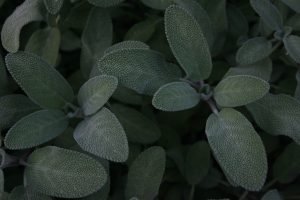
8: Sage
Not as common a herb in Australia but still amazing and delicious, sage love to grow indoors. Take a tip that has been cut from an outdoor plant to start an indoor sage plant. Sage tolerates dry, indoor air exceptionally well. However, it needs the strong sun from a south-facing window. With the right environment, sage will reward you with gorgeous silver foliage and a wonderful aroma.
Sage is an amazing addition to chicken, pork and sausage dishes, and perfect in the stuffing for a Christmas turkey!
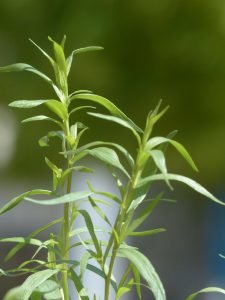
9: Tarragon
Another often forgotten, but incredibly tasty herb, needs a dormant period in late fall or early winter is essential for tarragon to grow indoors. Pot mature plants from your garden and leave it outside until the leaves die back. Bring it to your coolest indoor spot for a few days then place it in a south facing window for as much sun as possible. Feed it well with a liquid fertiliser to ensure healthy growth.
When cooking, chop the leave finely before adding to salad dressings, eggs, sauces, or meat. Tarragon has a similar flavour to anise or fennel.
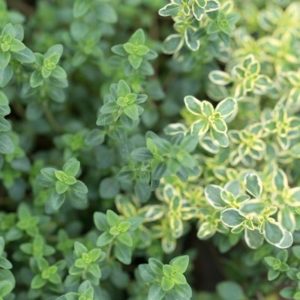
10: Thyme
Thyme is another classic herb and you can easily start by either rooting a softy tip cut from an outdoor plant or by digging up and repotting an entire plant. Thyme loves full sun but will happily grow in a window facing the east or west. You will also need to keep the soil moist and harvest sprigs as needed.
You can dry thyme leave by cutting whole stems and tying them into bunches. Hang in a dry, airy location, out of the sun. you can add either fresh or dried sprigs of thyme to roasts, sauces, soups, dressings, and more. You can also infuse them into honey or vinegars.
Looking to create your own indoor herb gardens? Come explore the range at Aumann’s today. We have a wide range of herbs and pots for you to create the indoor garden of your dreams. Our friendly staff can also help you find everything you need. Come in store, call us, or contact us today for more information.

